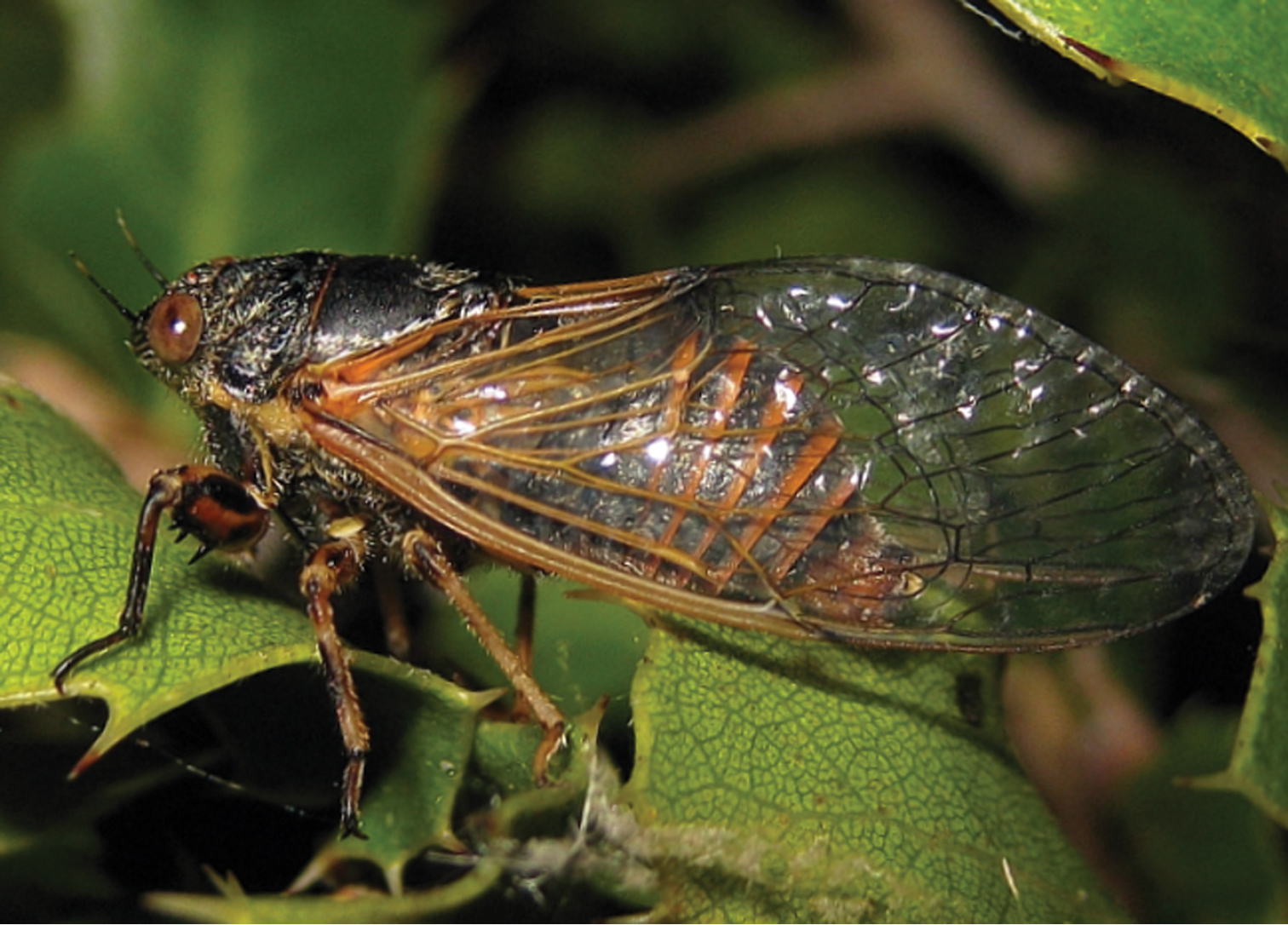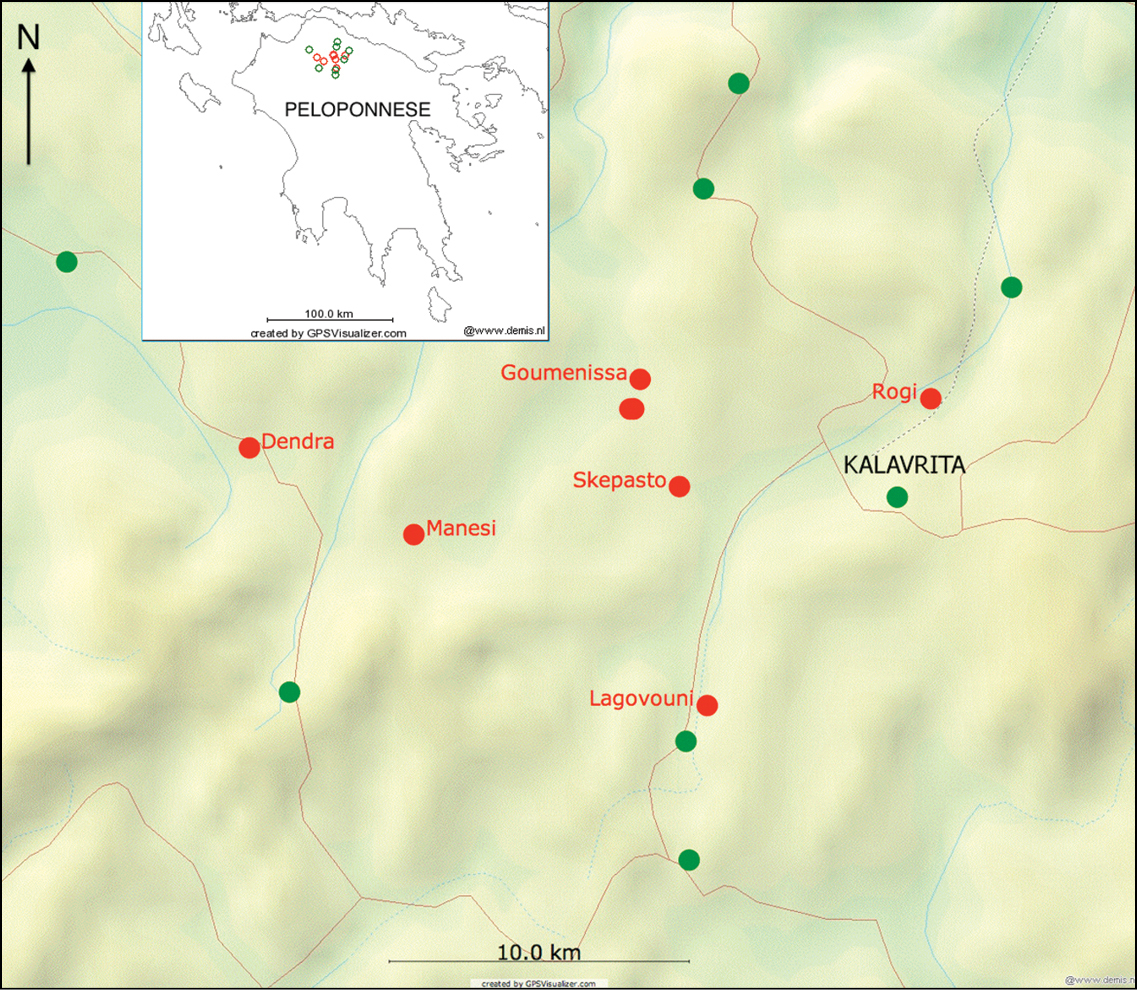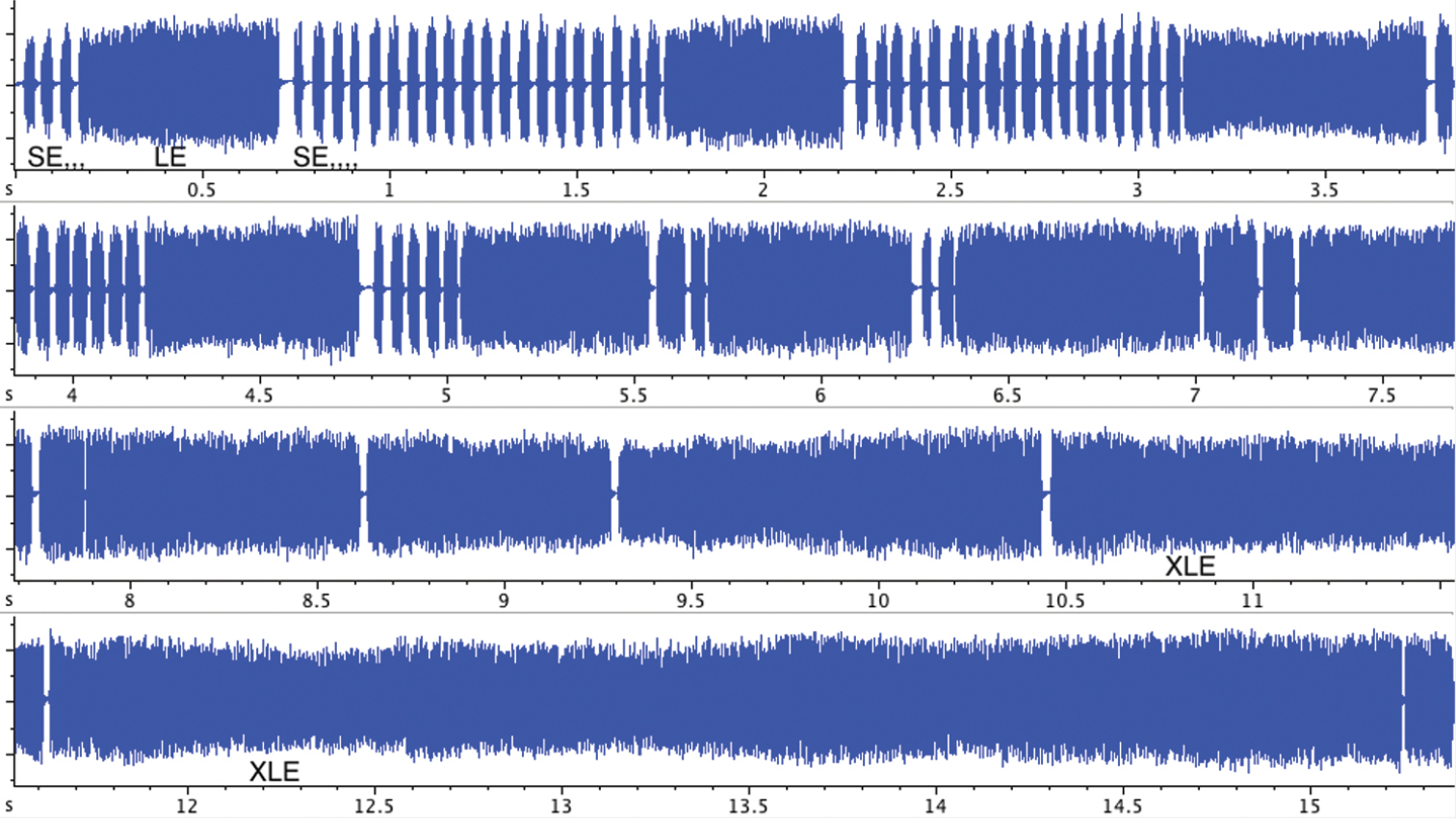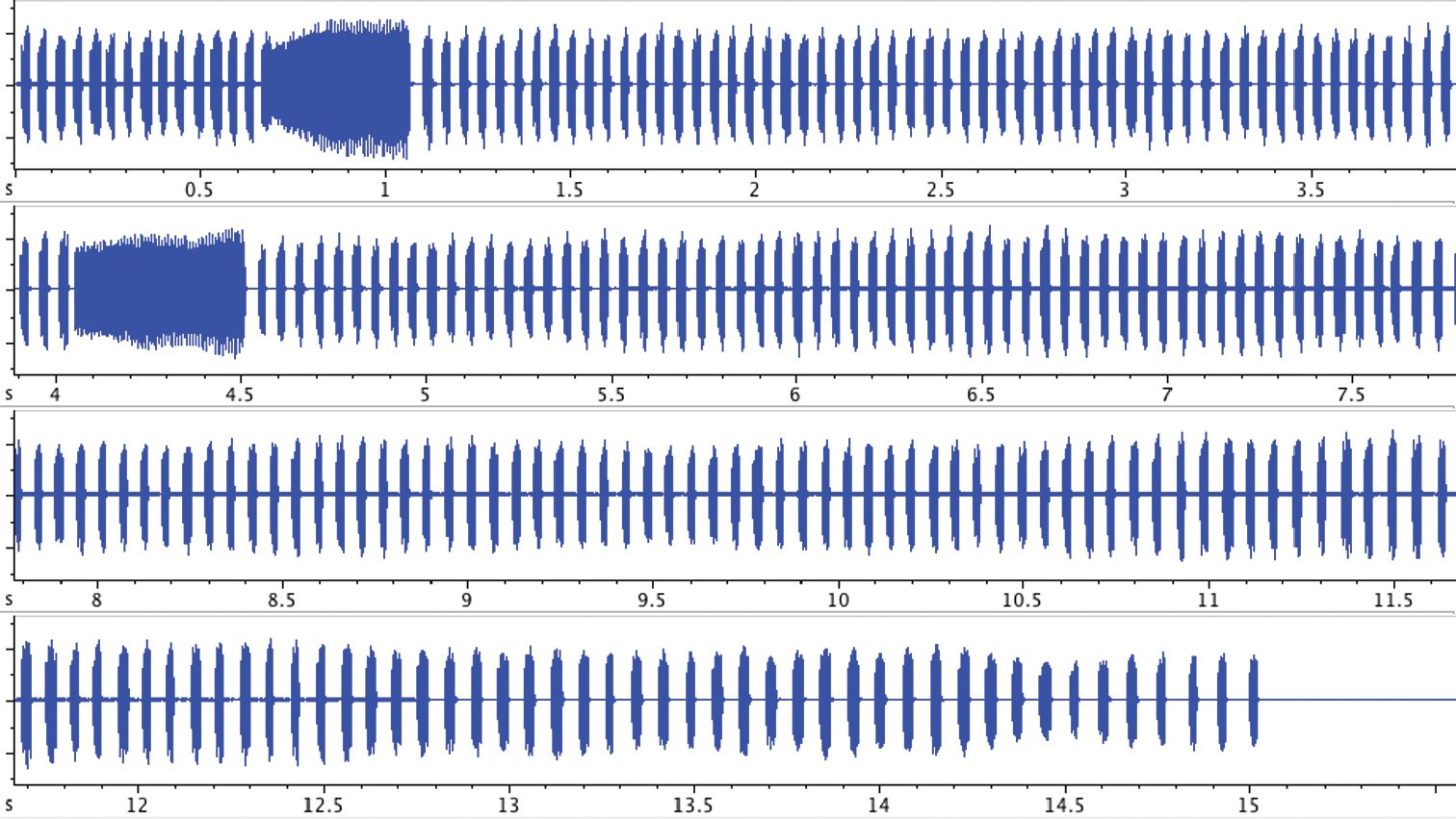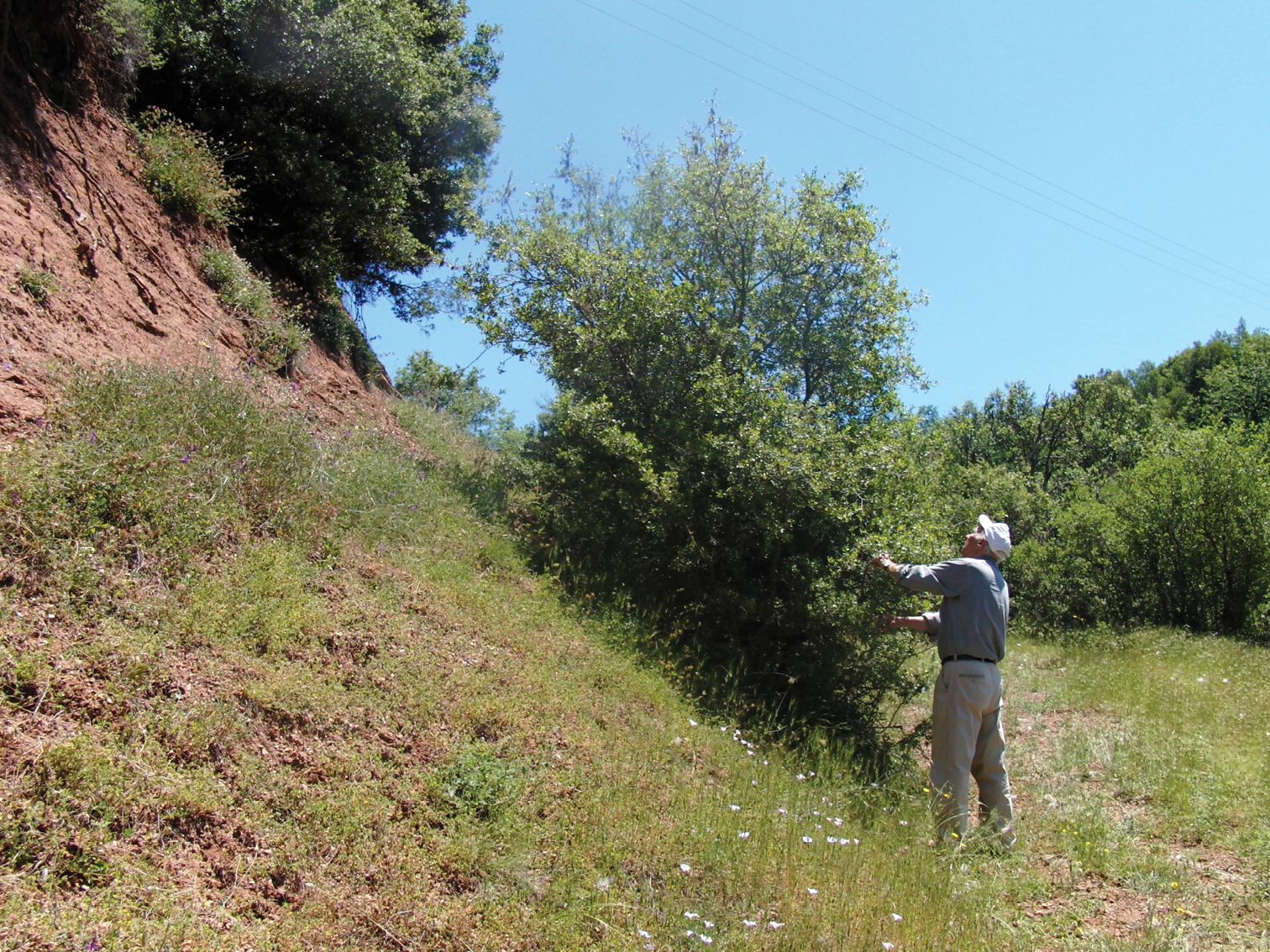






(C) 2013 Matija Gogala. This is an open access article distributed under the terms of the Creative Commons Attribution License 3.0 (CC-BY), which permits unrestricted use, distribution, and reproduction in any medium, provided the original author and source are credited.
For reference, use of the paginated PDF or printed version of this article is recommended.
Citation: Gogala M, Drosopoulos S, Trilar T (2013) New distributional and bioacoustic data about Cicadivetta goumenissa from Peloponnese, Greece (Hemiptera, Cicadidae). In: Popov A, Grozeva S, Simov N, Tasheva E (Eds) Advances in Hemipterology. ZooKeys 319: 83–91. doi: 10.3897/zookeys.319.4452
Cicadivetta goumenissa, a small singing cicada described recently by
Hemiptera, Cicadidae, Cicadivetta goumenissa, geographical distribution, song pattern
We found and described this year the new cicada species Cicadivetta goumenissa Gogala et al., 2012 in just a small area in northern Peloponnese, Greece (
We made a field trip to the Peloponnese from 9 to 11 of June, 2012. From previous visits to this area in 2005, 2006 and 2010 we knew that Cicadivetta goumenissa could not be found in July or later in the year.
We were searching for the presence of this cicada with bioacoustic equipment described below in localities around Kalavrita, Goumenissa, Pteri, Manesi, Vlasia, Dendra, Mirali, Priolithos, Lagovouni and on Mt. Erymanthos (see Table 1).
For the names and spelling of localities we follow the local inscriptions and transliterations used in the maps of the “Road Editions”, Nr. 4 and 5, Athens (1996).
The distribution map was created by GPS Visualizer (
For acoustic detection and recording of songs we used the ultrasonic detector Pettersson D-200 (heterodyne system) with electret microphones of the same producer (frequency range 10–120 kHz), mounted in front of a Telinga reflector (57 cm diameter) or a Renault R-4 front light reflector and connected to the solid state recorders Marantz PMD-660 (sampling rate up to 48 kS) or Zoom H2 (sampling rate up to 96 kS). Due to the high frequency range (see
For the nomenclature of cicadas we are following the publication of
Collected specimens are deposited in the collection of the Slovenian Museum of Natural History (PMSL). Song recordings are deposited in the Slovenian Wildlife Sound Archive of the same museum. A sample of a selected recording is available on the web pages Songs of European singing cicadas (http://www.cicadasong.eu).
We visited 13 localities in June 2012 and two more in previous years in the neighbourhood of Goumenissa (covering more than 200 km2) and tried to detect the characteristic sounds of Cicadivetta goumenissa. Reference to other cicada species found is also given (Table 1). Moreover, the visited localities are also shown on the map, where the places with presence of Cicadivetta goumenissa are shown in red and those without this species in green (Fig. 2).
During the last eight years we have searched for cicadas in many other localities in Greece, including several field trips to other parts of the Peloponnese (Mt. Menalo, Mt. Parnon, Kastanitsa, Agios Andreas etc.) and have never heard, recorded or collected Cicadivetta goumenissa. Therefore we assume that the distribution area of this species is really restricted to a very small area, not exceeding about 15 by 25 km.
List of localities, where we searched for Cicadivetta goumenissa. In the table are given the names of the localities (column 1), dates of visits (column 2), geographic coordinates with elevations (column 3) and names of the cicadas, heard (H), recorded (R), collected (C), observed (O) or photographed (P) in a particular locality (column 4). Included are also data from previous years. The shortened scientific names of species represent the following taxa:
C. goumenissa – Cicadivetta goumenissa Gogala, Drosopoulos & Trilar, 2012
C. flaveola – Cicadivetta flaveola (Brullé, 1832)
C. hannekeae – Cicadetta hannekeae Gogala, Drosopoulos & Trilar, 2008
C. atra – Cicadatra atra Fieber, 1776
C. orni – Cicada orni Linné, 1758
D. dimissa – Dimissalna dimissa (Hagen, 1856)
L. plebejus – Lyristes plebejus (Scopoli, 1763)
P. annulata – Pagiphora annulata (Brullé, 1832)
T. haematodes – Tibicina haematodes (Scopoli, 1763)
T. pygmea – Tettigetula pygmea (Olivier, 1790)
| Kalavryta, Goumenissa | 9. 6. 2005 | 38°3.63'N, 22°1.87'E 780 m |
C. goumenissa – R |
| Kalavryta, Goumenissa, deviation to Pteri |
9. 6. 2005 | 38°3.10N, 22°1.72E 740 m |
C. goumenissa – C, R T. pygmea – R |
| 9. 6. 2012 | 38°3.10'N, 22°1.63'E 720 m |
C. goumenissa – C, R T. pygmea – R D. dimissa – R T. haematodes – H, O |
|
| 28. 6. 2006 | 38°3.10'N, 22°1.72'E 720 m |
C. goumenissa – C, R C. atra – H T. haematodes – C D. dimissa – H T. pygmea – R C. flaveola – C, F L. plebejus – H |
|
| 16. 7. 2010 | 38°2.80'N, 22°1.30'E 720 m |
C. orni – H L. plebejus – H T. haematodes – H C. flaveola – C, R, P C. atra – H T. pygmea – R |
|
| Kalavryta, Petsaki, deviation to Valta | 28. 6. 2006 | 38°7.07'N, 22°3.32'E 970 m |
C. flaveola – R C. atra – H D. dimissa – H L. plebejus – P |
| Kalavryta, Skepasto (near the road to Goumenissa) | 9. 6. 2012 | 38°1.70'N, 22°2.77'E 800 m |
C. goumenissa – R |
| Kalavryta, Mega Spileo |
9. 6. 2012 | 38°5.29'N, 22°10.36'E 830 m |
D. dimissa – R |
| Kalavryta, (deviation to Kerpini and Rogi) | 9. 6. 2012 | 38°3.28'N, 22°8.51'E 740 m |
C. goumenissa – R T. pygmea – R T. haematodes – H C. flaveola – C, R |
| Kalavryta, road to Mt. Helmos |
10. 6. 2012 | 38°1.51'N, 22°7.75'E 970 m |
C. hannekeae – R T. haematodes – H C. flaveola – R D. dimissa – R |
| Kalavryta, Manesi | 10. 6. 2012 | 38°0.83'N, 21°56.69'E 860 m |
C. goumenissa – R T. pygmea – R T. haematodes – H C. flaveola – R |
| Ano Vlasia, Mt. Erymanthos |
10. 6. 2012 | 37°58.00'N, 21°53.85'E 1140 m |
C. hannekeae – R T. haematodes – R |
| Kalavryta, Lagovouni | 10. 6. 2012 | 37°57.75'N, 22°3.40'E 770 m |
C. goumenissa – R |
| Kalavryta, Lagovouni, deviation to Kandalos | 10. 6. 2012 | 37°57.11'N, 22°2.92'E 750 m |
D. dimissa – R T. pygmea – R C. flaveola – R T. haematodes – R |
| Klitoria, Priolithos, near the monument | 10. 6. 2012 | 37°54.97'N, 22°2.99'E 1020 m |
T. pygmea – R C. flaveola – R |
| Kalavryta, Kampigadi, Dendra | 11. 6. 2012 | 38°2.40'N, 21°52.94'E 670 m |
C. goumenissa – C, R P. annulata – H T. haematodes – R T. pygmea – R C. flaveola – R D. dimissa – R |
| Halandritsa, deviation to Mirali |
11. 6. 2012 | 38°5.75'N, 21°48.76'E 470 m |
P. annulata – H T. haematodes – R T. pygmea – R D. dimissa – R |
| Pteri | 28. 6. 2006 | 38°8.79'N, 22°4.53'E 1060 m |
C. hannekeae – R C. flaveola – C, R, P |
During our last excursion to the Kalavrita and Goumenissa region we made many new recordings (more than one hour) of the Cicadivetta goumenissa song. Therefore, we can further comment on our description of the song pattern published previously (
The main addition to this description is that the part of the song with longer echemes and a few or even without short echemes interspersed is apparently a regular part of the song and not an exception. Such phrases appear usually in the middle part of a song sequence (Fig. 3). The long echemes (LE) in such phrases can in extreme cases fuse to the longest echemes (XLE), which can last up to 15 s. Therefore the part of a song with such extremely long echemes resembles the so called continuous song of Cicadatra atra or related species.
The whole song starts usually, but not always, with a long echeme followed by a sequence of short echemes (SE). The first long echeme may have also a preceding SE. The main part of the song comprises phrases of some SE and one LE, as described previously (
In most cases Cicadivetta goumenissa males are perching and singing on branches of Kermes Oak (Quercus coccifera) as described earlier (
Male of Cicadivetta goumenissa on leaves of Kermes Oak (Quercus coccifera) (Photo T. Trilar).
Distribution map of Cicadivetta goumenissa. Red points – localities with Cicadivetta goumenissa, green points – localities where we searched for but did not find this species. Map created by GPS Visualizer (
Oscillogram of the song selection of Cicadivetta goumenissa with the transition from prevailing phrases with SE sequence followed by LE toward the phrases with very long echemes XLE with a few SE or without them.
Oscillogram of the song selection of Cicadivetta goumenissa at the end of the song with long sequences of SE and with decreasing repetition rate.
Why this cicada species is present only in such a restricted area, as described above, is one of the most puzzling questions concerning Cicadivetta goumenissa. We do not see any reason why this cicada would not be able to move to other places, disperse and acquire similar habitats nearby. One possible explanation is that they are, unlike other cicadas, in the larval stage bound to restricted plant species. However, we do not have yet any sound evidence for this hypothesis. Nevertheless, the distribution of endemic cicada species of Evia shows clear similarities with the distribution of endemic plant species on this island (
The type of vegetation in the distribution area of Cicadivetta goumenissa is everywhere very similar and can be described as garrigue or phrygana vegetation with Kermes Oak (Quercus coccifera) and other typical shrubs (Fig. 5).
Another possibility would be that this species was in the geological past confined to a small refugium and adapted to particular environmental conditions, which can be found only in the described habitat in this area. We have seen that one environmental parameter, the elevation of localities with Cicadivetta goumenissa, is in all cases very similar. The lowest value is according to our measurements 670 m, the highest 860 m and the average 750 m. Is here hidden a hint for its limited distribution?
In the paper with the original description of Cicadivetta goumenissa we have already mentioned the unusually high repetition rate of short echemes in the song (13-22 SE/s). In the southern part of Greece there are some other species with a high SE rate such as Cicadivetta flaveola (7-11 SE/s), which is found everywhere on the Peloponnese and in some other localities on the Greek mainland. This species occurs also in the distribution area of Cicadivetta goumenissa in sympatry with the latter. Another example is also Cicadivetta carayoni (Boulard, 1982), an endemic species of Crete with a similar rate of SE in its song (
The garrigue or phrygana habitat in the locus typicus of Cicadivetta goumenissa near Goumenissa.
Cicadivetta goumenissa occurs particularly in early June. It is, as expected, not restricted to the neighbourhood of the village Goumenissa, but can be found also in surrounding localities with a similar habitat. Nevertheless, we found it only in an area of about 15 ×25 km. From the new sound recordings here analysed we came to the conclusion that also the phrases with long echemes and without or with only a few short echemes are a regular component of its song and not just an exception.
We are grateful to Andrej Gogala (Slovenian Museum of Natural History, Ljubljana), who did again the preparations of the material. We appreciate the financial support to one of us (MG) by the Slovenian Academy of Sciences and Arts. The research of one of us (TT) was part of the program “Communities, relations and communications in the ecosystems” (No. P1- 0255) financed by Ministry of Higher Education, Science and Technology of the Republic of Slovenia. We are grateful to both reviewers Jérôme Sueur and José Quartau for useful suggestions and corrections.
